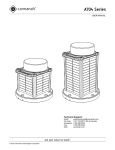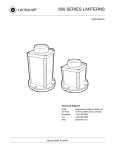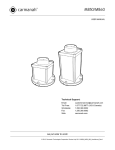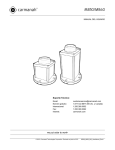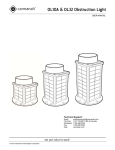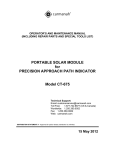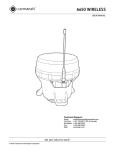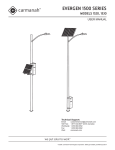Download Carmanah 502 Owner`s manual
Transcript
OWNER’S MANUAL Model 502 Solar LED Light Owner’s Manual | Model 502 Contents 1.0 Introduction ....................................................................................................................... 4 2.0 Infrared Programmer ........................................................................................................ 5 2.1 3.0 Setting up the Programmer ............................................................................................................ 5 Programming a Light ........................................................................................................ 6 3.1 Transitioning the Light .................................................................................................................... 6 3.2 Programming Sequence................................................................................................................. 6 3.3 Entering the Security Code............................................................................................................. 8 3.4 Changing the Flash Pattern............................................................................................................ 8 3.5 Automatic Light Control .................................................................................................................. 9 3.5.1 Turning ALC off or on ................................................................................................................ 9 4.0 Storing a Light................................................................................................................. 10 4.1 4.2 4.3 Storage Mode ............................................................................................................................... 10 Sleep Mode................................................................................................................................... 10 Turn the Light On Manually .......................................................................................................... 10 5.0 Testing the Battery.......................................................................................................... 11 6.0 Recharging a Light.......................................................................................................... 12 7.0 Appendices...................................................................................................................... 13 Appendix A: A-1: Original Infrared Programmer ....................................................................... 13 Setting up the Programmer ..................................................................................................... 13 Appendix B: Frequently Asked Questions......................................................................... 14 Appendix C: Glossary of Terms .......................................................................................... 15 Appendix D: Warranty and Customer Service ................................................................... 15 D-1: D-2: Warranty .................................................................................................................................. 15 Customer Service .................................................................................................................... 15 3 © 2008 Carmanah Technologies Corporation Revised: August 2008 Owner’s Manual | Model 502 1.0 Introduction Carmanah Model 502 lights are small, self-contained, and easy to operate. During daylight hours, the light is dormant and charges its battery from the available sunlight. At night, the light flashes according to a customer-specified flash pattern. You can configure the light at any time by transitioning it from dark to light. The infrared programmer enables you to configure or check the following settings: flash pattern light intensity automatic light control state of charge for the battery In addition to this basic functionality, the light also includes the following features: Ship mode: Conserves power while the product is sealed in a box. 24-hour shutdown mode: The light turns off after more than 24 hours of darkness has been detected, as may happen if the light is placed in a box or if the solar panel is covered. This mode prevents complete discharge of the battery if the solar-recharge operation is prevented from functioning. Low battery mode: Displays a low battery flash once the battery is discharged past its normal operational limits. 4 © 2008 Carmanah Technologies Corporation Revised: August 2008 Owner’s Manual | Model 502 2.0 Infrared Programmer All functions of the Model 502 light are controlled by an infrared programmer. Carmanah currently supports both the original and the updated infrared programmers. The only differences between the two programmers are the faceplate and setting up the programmers; all other functionality remains the same. To set up the programmer and see the faceplate details for the original Carmanah programmer, see Appendix A: Original Infrared Programmer. Using the programmer you can perform the following functions: change the flash pattern set the automatic light control turn the light off and on test the light Once the settings are programmed, the light can be immediately deployed or placed in a box for storage or shipping. If placed in a box, the light automatically turns off after 24 hours. All the previously programmed settings become active when the light is removed from the box. Table 2-1: Programmer Buttons describes the buttons for the programmer. Table 2-1: Programmer Buttons Button or Symbol Description Use the Start button to initiate a programming sequence. Use the Enter button to complete a programming sequence. This symbol indicates that a numerical entry is required. Table 2-2: Light Programming Symbols describes the symbols used in this manual to indicate the response from the Model 502 light during programming. Table 2-2: Light Programming Symbols Symbol Description The single burst symbol represents the single flash from the light indicating a correct entry. The double burst symbol represents two longer flashes from the light which indicates an incorrect entry. The code has not been accepted and you must restart the programming sequence. The triple burst symbol represents three quick flashes from the light indicating that the code has been accepted. 2.1 Setting up the Programmer To set up the infrared programmer, install two new AAA batteries. 5 © 2008 Carmanah Technologies Corporation Revised: August 2008 Owner’s Manual | Model 502 3.0 Programming a Light You can customize the light settings using the programmer. Before programming the settings you must transition the light and enter the security code. You can then program the settings listed in Table 3-1: Programmable Settings. Table 3-1: Programmable Settings Setting Section Change the flash pattern 3.4 Set automatic light control 3.5 Turn the light off: Storage mode 4.1 Sleep mode Turn the light on 4.2 4.3 3.1 Transitioning the Light To make any change to the settings of the light, you must transition the light from night to day mode. The light only accepts programming commands while it is exposed to light. The light cannot be programmed in darkness. After transitioning the light you must enter the security code in order to proceed with the programming; see section 3.3 Entering the Security Code. If, after transition, the light does not respond to the programmer, remove and re-install the programmer batteries and repeat the programming instructions for the required function. Transition a new light: 1. Remove the light from the shipping box and place it in full sunlight or under an incandescent light for at least 3 seconds. 2. Move the light into darkness and wait 3 seconds. 3. Move the light back into the light. 4. While the light is exposed to the light, point the programmer at the light and press the Start button; when the light responds with a flash, it is ready for programming. Transition an installed light: During the day: 1. Cover the light with an opaque material for at least 3 seconds. 2. Uncover the light. 3. While the light is exposed to the light, point the programmer at the light and press the Start button; when the light responds with a flash, it is ready for programming. At night: 1. Force a transition to day by placing the light under an incandescent light for at least 3 seconds. 2. While the light is exposed to the light, point the programmer at the light and press the Start button; when the light begins to flash, it is ready for programming. 3.2 Programming Sequence The infrared sensor in the light responds to commands from the programmer for 1 minute after transition of the light. The infrared sensor switches off automatically after 1 minute to conserve power. 6 © 2008 Carmanah Technologies Corporation Revised: August 2008 Owner’s Manual | Model 502 You can program multiple settings within one session by pressing any button within the 1 minute window that the infrared sensor is on. Pressing the Start button causes the infrared sensor to remain on for an additional minute from the time the button was pressed. If the button is not pressed within the 1 minute window you must re-transition the light and re-enter the security code to complete or continue programming the light. When programming a Model 502 light, the key sequence on the programmer and the responding flash sequence from the light is always in the format shown in Figure 3-1 regardless of the settings being configured. Figure 3-1: Programming Sequence Press Start Single flash from the light Press the first number of the code Single flash from the light Press the second number of the code Single flash from the light Press the third number of the code Single flash from the light Press Enter Single flash from the light Do not press the buttons on the programmer too fast and do not proceed until you see a flash from the light. One of the flash patterns described in Table 3-2: Programming Completion displays after the programming sequence is complete. The flash pattern indicates whether or not the programming was successful. Table 3-2: Programming Completion Programming Result Flash Pattern Description Successful Three quick consecutive flashes indicate that the code has been accepted. You will see this flash after every successful entry. Unsuccessful Two longer flashes indicate that the code has not been accepted. Restart the programming sequence. Figure 3-2: Successful Programming Sequence Figure 3-3: Unsuccessful Programming Sequence An unsuccessful programming sequence for the Model 502 light occurs for one of the following reasons: the light does not recognize the sequence, or the light has not received the correct security code If the programming sequence is unsuccessful, re-enter the key sequence for the required code. If the programming sequence is still unsuccessful, re-enter the security code. 7 © 2008 Carmanah Technologies Corporation Revised: August 2008 Owner’s Manual | Model 502 3.3 Entering the Security Code After the light is transitioned, you must enter the programming security code before you can make any changes to the Model 502 light’s settings. You must enter the security code every time the light is transitioned. The security code is 753. 1. Transition the light. 2. Enter the security code: 7 5 3. 7 5 3 Once the security code has been successfully entered, you can program the settings listed in Table 3-1: Programmable Settings. 3.4 Changing the Flash Pattern You can change the flash pattern of the light by entering a flash code. 1. Transition the light (if required). 2. Enter the security code (if required). 3. Program the new flash pattern by entering the required flash code; see Table 3-3: Model 502 Flash Codes. where # is a number of the flash code; Table 3-3: Model 502 Flash Codes Table 3-3: Model 502 Flash Codes Flash Code Flash Character FL1 EC1 FL2 000 Off 0 0 001 Fixed 1 0 0.25 055 Fl 2s 0.5 1.5 0.70 064 Fl 4s 0.5 3.5 0.70 066 Fl 4s 1 3 0.80 072 Fl 6s 0.5 5.5 0.70 129 Q 1s 0.3 0.7 0.50 147 Q(5) 20s 0.3 0.7 209 Q 1s 0.15 0.85 0.3 EC2 0.7 FL3 0.3 EC3 0.7 FL4 0.3 EC4 0.7 FL5 0.3 EC5 15.7 Effective Intensity (cd) 0.60 0.70 After successfully entering a flash code cover the light with an opaque material to simulate night. The light will display a quick flash, and then display the programmed flash pattern. The infrared sensor remains on while the light displays the programmed flash pattern. If required, you can interrupt the flash pattern at any time by transitioning to light, pressing the Start button, and entering a different code. 8 © 2008 Carmanah Technologies Corporation Revised: August 2008 Owner’s Manual | Model 502 3.5 Automatic Light Control The Automatic Light Control (ALC) function of the Model 502 light monitors the battery voltage and reduces the light’s intensity level if the light is not receiving sufficient solar charging to maintain the battery voltage. If a light is set at the correct intensity setting for the available solar illumination, ALC is not required except in unusual circumstances of poor solar illumination. If the light is manually set at a higher intensity it will operate at that higher intensity during the summer months, but may turn itself down during the winter months in definable steps. If you do not want the intensity level reduced automatically, you must turn ALC off; see section 3.5.1 Turning ALC off or on. Disabling ALC while also increasing the light's intensity beyond a sustainable level will cause the battery to over-discharge and the light will fail. 3.5.1 Turning ALC off or on Turning ALC off prevents the light from automatically adjusting the intensity level of the programmed flash pattern based on the available battery voltage. If ALC is turned off, you must set the required intensity level for the light. Turning ALC on allows the light to automatically adjust the intensity level of the programmed flash pattern based on the available battery voltage. Turning ALC Off: 1. Transition the light (if required). 2. Enter the security code (if required). 3. Enter the flash code (if required). 4. Enter code 8 0 0 to turn ALC off. 8 0 0 Turning ALC On: 1. Transition the light (if required). 2. Enter the security code (if required). 3. Enter the flash code (if required). 4. Enter code 8 0 1 to turn ALC on. 8 0 1 9 © 2008 Carmanah Technologies Corporation Revised: August 2008 Owner’s Manual | Model 502 4.0 Storing a Light You can store or ship a light by placing it in either storage mode or sleep mode. Store a light if it is not going to be used for an extended period of time or if is being shipped to an alternate location and you do not want it to turn on during transit. When you store a light ensure that it is fully charged. The batteries must not be stored in a discharged state. Elevated storage temperatures increase the rate of battery self-discharge. The optimum storage temperature for a light is 68 °F (20 °C) or cooler. Check the battery level of the light at least every 3 months. For more information on testing the light battery, see section 5.0 Testing the Battery. 4.1 Storage Mode Using the storage code to turn the light off for storage or shipping allows the light to recharge in sunlight without the need to transition or reprogram. With the storage code, the light charges during the day and does not turn on at night. The light remains off until it is transitioned and turned on by entering the security code and flash pattern using the programmer. The storage code is 0 0 0. Use the storage code when: the light is being shipped to a location where there is an available programmer for turning the light on the light will be exposed to intermittent light; for example, it is not sealed in a box the light is being recharged using daylight; turning the light off prevents it from turning on at night and using the charge gained during the day Placing the light in storage mode: 1. Transition the light (if required). 2. Enter the security code (if required). 3. Enter the storage code 0 0 0 to place the light in storage mode. 0 0 0 4.2 Sleep Mode A light automatically enters sleep mode (switches off) when placed in darkness for 24 hours. If you are storing the unit in sleep mode, do not expose it to light again until it is to be deployed. If a light in sleep mode is exposed to light, it will resume normal operation for at least 24 hours. It will return to sleep mode only if it is in continual darkness for 24 hours. 4.3 Turn the Light On Manually The light only needs to be turned on if it has been turned off using code 0 0 0. To turn the light on you must transition the light and enter the security code; see 3.3 Entering the Security Code. Once the light is on, the infrared sensor is turned on for 1 minute and you can program the light as usual. 10 © 2008 Carmanah Technologies Corporation Revised: August 2008 Owner’s Manual | Model 502 5.0 Testing the Battery Storing a light in a low state of charge can damage the battery and cause it to lose its ability to hold a charge. To determine the state of charge of the batteries in a light, transition the light, if needed, and enter code 8 1 0; the light will respond with a series of flashes: Single flash: the state of charge is less than 30% Two flashes: the state of charge is greater than 30%, but less than 75% Three flashes: the state of charge is greater than 75% For information on recharging the light see section 6.0 Recharging a Light. Testing the light battery: 1. Transition the light (if required). 2. Enter the security code (if required). 3. Enter code 8 1 0 to test the battery. 4. Count the number of flashes from the light. 8 1 0 11 © 2008 Carmanah Technologies Corporation Revised: August 2008 Owner’s Manual | Model 502 6.0 Recharging a Light If the light is in use and in a low battery state, displays a single quick flash once every minute to indicate that the light needs charging. The light cannot be programmed or transitioned until it is charged. The light must also be charged if it has a charge of 75% or less while in storage or sleep mode. Charge the light in accordance with the recommended minimum temperatures listed in Table 6-1: Battery Storage and Charging in conjunction with the guidelines for hours of charging with different light sources presented in Table 6-2: Charging Alternatives. Following the guidelines ensures that the light is charged safely and the battery is kept fully charged over extended storage periods. Table 6-1: Battery Storage and Charging Storage Temperature Recharge Interval (Months) ° ° 20 or lower 68 or lower 9 25 77 6 30 86 4 35 95 2.5 40 104 1.5 45 or higher 113 or higher 1 C F To recharge a light, turn it off using the storage code and follow the guidelines in Table 6-2: Charging Alternatives. The battery will not recharge under fluorescent lighting. Placing the light source too close to the light will overheat the solar panel and invalidate the warranty. Table 6-2: Charging Alternatives Light Source Distance from Solar Panel 500 W halogen 24 inches (60 cm) 60 W incandescent light bulb 12 inches (30 cm) Direct sunlight (light should turned off using code 000) – 12 © 2008 Carmanah Technologies Corporation Revised: August 2008 Hours to Charge from 10% to 100% 100 25 Owner’s Manual | Model 502 7.0 Appendices Appendix A: Original Infrared Programmer All functions of the Model 502 light are controlled by an infrared programmer. Carmanah currently supports both the original and the updated infrared programmers. The only differences between the two programmers are the faceplate and setting up the programmers; all other functionality remains the same. Table 7-1: Programmer Buttons describes the buttons for the original Carmanah programmer. See section 3.0 Programming a Light for the light programming procedures. Table 7-1: Programmer Buttons Button or Symbol | S Description Use the OFF-ON button to initiate a programming sequence. Use the Channel Up button to end a programming sequence. This symbol indicates that a numerical entry is required. A-1: Setting up the Programmer The light is not required to be present when setting up the programmer. Perform the following steps to setup the infrared programmer: 1. Install two AAA batteries. 2. Press and hold the Code Search button until the red indicator light lights up, then release the Code Search button. 3. Press and release the TV button. The indicator light will blink and then remain lighted. 4. Enter code 0 0 6 using the number buttons. The indicator light will turn off. The remote is now ready to use for programming the light. Whenever batteries are replaced in the programmer, you need to set-up the programmer again using steps 2 to 4 above. If the light does not respond to the programmer, remove and re-install the batteries and set-up the programmer again. 13 © 2008 Carmanah Technologies Corporation Revised: August 2008 Owner’s Manual | Model 502 Appendix B: Frequently Asked Questions This section lists some frequently asked questions regarding Carmanah lights. If you have questions that are not answered through this manual, contact Carmanah Technologies Corporation; see Appendix D: Warranty and Customer Service. Q: The light is not responding to the infrared programmer. What is wrong? A: Ensure that the batteries in the remote are installed and still charged, and that the remote has been set-up correctly. Ensure that the light is subjected to a transition from dark to light. The transition turns on the infrared sensor for 1 minute. Q: Your brightness measurements are in candelas. What’s that in watts? A: Watts are not a measurement of light. Watts are a measure of how much energy a light bulb consumes, not how much light it produces. In incandescent light bulbs only a small percentage of the energy consumed is converted to light and the rest is dissipated as heat. A light bulb running at 120 V using 0.5 A current is known as a 60 W light bulb since it consumes 60 W of electricity. LED lights are very efficient in that nearly all the energy consumed is converted to light rather than heat. Q: It’s been raining a lot here. Will my light stop working? A: A Carmanah light is a solar light and it does require solar energy to work. However, it can run for 150 hours at full intensity, or 600 hours at low intensity without recharging. Q: My light has stopped working. What do I do? A: If the light does not respond to the programmer, does not flash or emits very brief flashes once a minute when placed in the dark, it means that the batteries have discharged and require recharging. See section 6.0 Recharging a Light for information on how to properly charge the light. If the light is not flashing in the dark, it may be because the light is in storage mode. Turn it on by transitioning the light, entering the security code and programming a flash code. If the light still does not function correctly, contact Carmanah Technologies Corporation. Q: What happens if birds perch on the light? A: Although the top of a light does not have a bird deterrent, we have not had problems with bird excrement accumulating on the domes; the solar panel is domed and relatively self-cleaning when it rains. Q: Can I glue a bird deterrent to the top of the light? A: Gluing the bird deterrent to the light is not recommended as it may prevent the light from functioning properly. Q: Are the lights bullet-proof? A: Carmanah does not guarantee that the lights are bullet-proof. 14 © 2008 Carmanah Technologies Corporation Revised: August 2008 Owner’s Manual | Model 502 Appendix C: Glossary of Terms Autonomy: The length of time a light can produce light without recharging. Candela: The standard measure of luminous intensity based on the response of the human eye. Duty Cycle: The amount of time the light is on over an entire cycle of flash pattern. For example, a pattern of 0.5 seconds on, 3.5 seconds off has a 12.5% duty cycle or 0.5s/4s (time on/total time). Effective Intensity: The amount of brightness the human eye perceives. Equivalent Intensity: The average brightness a flashing light emits. Fixed Light: A light showing continuously and steadily. Flash Character: The properties of a light that distinguish its appearance. Flashing Light: A light in which the total duration of light in a period is shorter than the total duration of darkness, and the appearance of light (flashes) are usually of equal duration. Intensity: The quantity (in candelas) of light reaching the eye of an observer after the light emitted by a source has gone through a lens, filter, or protective covering. Lux: 1 candela’s brightness at 1 meter’s distance = 1 lux. Nominal Range: The luminous range of a light when the meteorological visibility is 18 nm (T=0.74). Peak Intensity: The maximum brightness a light emits. Signal Color: The color of the light exiting the light, for example, red, green, white; defined by its charted chromaticity coordinates or the wavelength of the light (in nanometers). Vertical Divergence: Angle over which the light exits the light in the vertical axis. A greater vertical divergence increases the allowable tilt of the light but reduces the intensity of the light. Appendix D: Warranty and Customer Service D-1: Warranty This product is covered by the Carmanah warranty. Visit www.carmanah.com/content/products/warranty/ for additional information or to register your product online. D-2: Customer Service Before contacting Carmanah’s customer service department, please have the serial number of the Model 502 light available, a brief description of the problem, as well as all details of installation and recharging efforts. To contact Carmanah’s Customer Service Department: Mail: Carmanah Technologies Corporation Building 4, 203 Harbour Road Victoria, BC Canada V9A 3S2 Phone: 1.250.380.0052 1.877.722.8877 (Toll Free in U.S. and Canada) Fax: 1.250.380.0062 Email: [email protected] Website: carmanah.com 15 © 2008 Carmanah Technologies Corporation Revised: August 2008 © 2008 Carmanah Technologies Corporation carmanah.com Technical Support: [email protected] Toll Free in Canada and U.S.: 1.877.722.8877 International: 1.250.380.0052 | Fax: 1.250.380.0062 Number: 502_53510_Manual_vB 53510
















